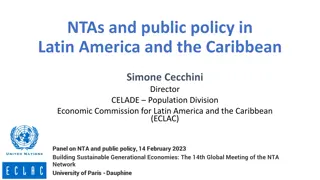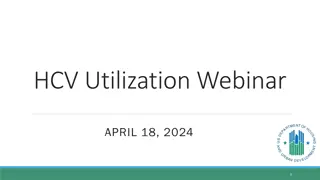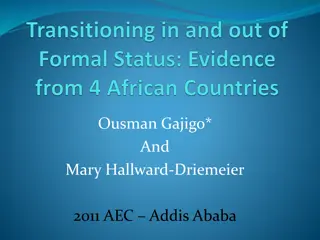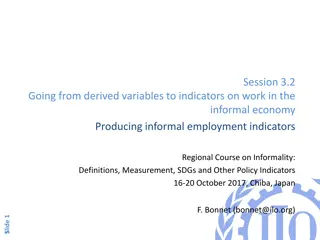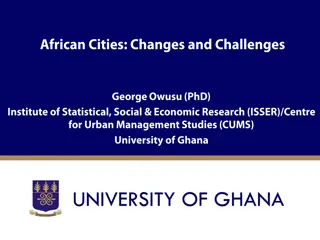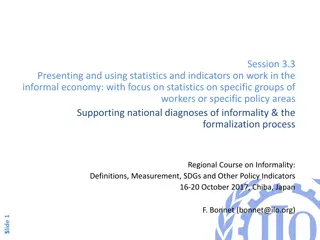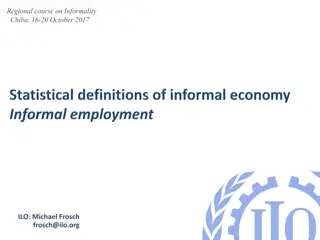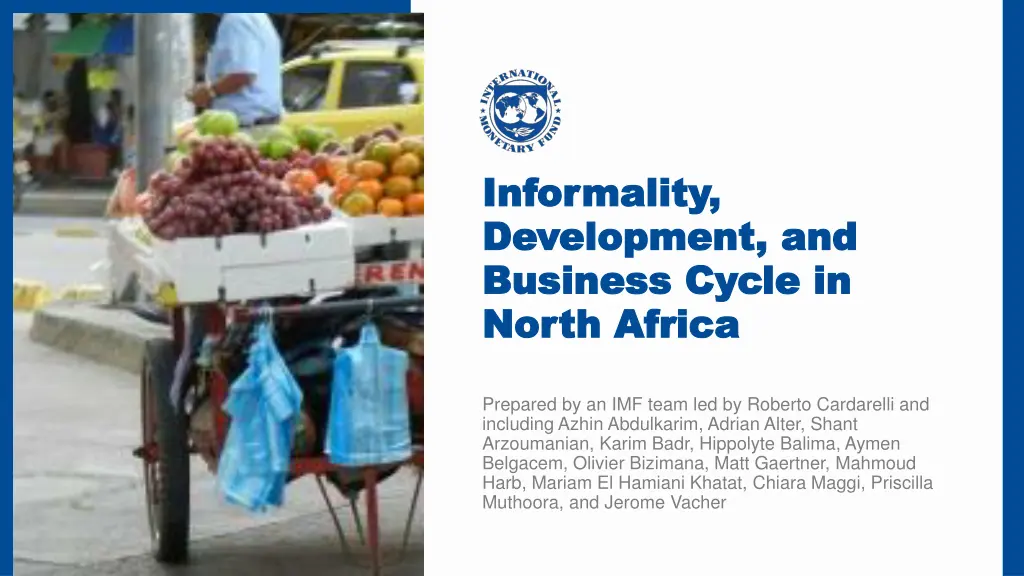
Informality, Development, and Business Cycle in North Africa
Explore the impact of informality on economic development in North African countries and how policy distortions play a role. Learn about the challenges of excess informality and its implications on labor markets, especially during economic downturns like the Covid-19 crisis.
Download Presentation

Please find below an Image/Link to download the presentation.
The content on the website is provided AS IS for your information and personal use only. It may not be sold, licensed, or shared on other websites without obtaining consent from the author. If you encounter any issues during the download, it is possible that the publisher has removed the file from their server.
You are allowed to download the files provided on this website for personal or commercial use, subject to the condition that they are used lawfully. All files are the property of their respective owners.
The content on the website is provided AS IS for your information and personal use only. It may not be sold, licensed, or shared on other websites without obtaining consent from the author.
E N D
Presentation Transcript
Informality, Informality, Development, and Development, and Business Cycle in Business Cycle in North Africa North Africa Prepared by an IMF team led by Roberto Cardarelli and including Azhin Abdulkarim, Adrian Alter, Shant Arzoumanian, Karim Badr, Hippolyte Balima, Aymen Belgacem, Olivier Bizimana, Matt Gaertner, Mahmoud Harb, Mariam El Hamiani Khatat, Chiara Maggi, Priscilla Muthoora, and Jerome Vacher INTERNATIONAL MONETARY FUND INTERNATIONAL MONETARY FUND 1
Background Background North African economies exhibit sizable informality Informality hinders economic development To a certain extent, however, informality is a symptom of economic underdevelopment, and can work as a buffer against economic shocks But informality can also be the consequence of policy distortions INTERNATIONAL MONETARY FUND INTERNATIONAL MONETARY FUND 2
The paper addresses three questions The paper addresses three questions 1. To what extent is informality in North African countries explained by their level of development, as opposed to policy distortions? 2. What are the main policy distortions that could lead to excess informality in North Africa? 3. How does informality in North African countries impact labor markets during downturns, particularly in light of the Covid-19 crisis? INTERNATIONAL MONETARY FUND INTERNATIONAL MONETARY FUND 3
Informality in North Africa: Stylized Facts INTERNATIONAL MONETARY FUND INTERNATIONAL MONETARY FUND 4
Informality in North Africa: Stylized Facts Measuring Informality INTERNATIONAL MONETARY FUND INTERNATIONAL MONETARY FUND 5
Informality in NA: Stylized Facts Measuring informality Measuring informality Informality is defined around three key dimensions in the literature Informal sector: unincorporated enterprises not registered Informal employment: based on the characteristics of the job Informal economy: economic activities not covered or insufficiently covered by formal arrangements This paper looks at a series of commonly used indicators of informality: The Schneider index: share of production hidden from official authorities The share of informal employment in total employment Share of workers not contributing to a retirement pension scheme Share of self-employed workers INTERNATIONAL MONETARY FUND INTERNATIONAL MONETARY FUND 6
Informality in North Africa: Stylized Facts Informality in North Africa INTERNATIONAL MONETARY FUND INTERNATIONAL MONETARY FUND 7
Informality in NA: Stylized Facts North Africa North Africa generally generally exhibits exhibits relatively high relatively high informality informality based on these based on these indicators indicators INTERNATIONAL MONETARY FUND INTERNATIONAL MONETARY FUND 8
Informality in NA: Stylized Facts The level of The level of informality in informality in North Africa North Africa reflect several reflect several factors. factors. INTERNATIONAL MONETARY FUND INTERNATIONAL MONETARY FUND 9
Informality in NA: Stylized Facts Informality in North Informality in North Africa is higher in Africa is higher in rural areas and the rural areas and the agriculture sector agriculture sector INTERNATIONAL MONETARY FUND INTERNATIONAL MONETARY FUND 10
Informality in NA: Stylized Facts Informality Informality trends in the trends in the region differ by region differ by indicator and indicator and country. country. INTERNATIONAL MONETARY FUND INTERNATIONAL MONETARY FUND 11
Informality in North Africa: Stylized Facts Characteristics of Informal Workers INTERNATIONAL MONETARY FUND INTERNATIONAL MONETARY FUND 12
Characteristics Characteristics of informal of informal workers in workers in North African North African countries countries INTERNATIONAL MONETARY FUND INTERNATIONAL MONETARY FUND 13
Informality in NA: Stylized Facts A large wage gap exists between informal and formal A large wage gap exists between informal and formal workers. workers. INTERNATIONAL MONETARY FUND INTERNATIONAL MONETARY FUND 14
To what extent is informality in North Africa countries explained by their level of development, as opposed to policy distortions? INTERNATIONAL MONETARY FUND INTERNATIONAL MONETARY FUND 15
Level of development vs policy distortions Explaining informality: Structural ( level of Explaining informality: Structural ( level of development ) characteristics vs policy distortions development ) characteristics vs policy distortions Informalit??= ?0+ ?1 ???????????+ ?2 ?????????+ ?3 ????????????+ ?4 ?????????+ ?5 ???????????+ ?? ???????????? proxied by Schneider index in the baseline; and the share of workers not contributing to a retirement pension scheme in robustness ??????????? proxies the level of development based on four variables: average years of schooling, share of youth, share of agriculture employment, share of rural population. ???????????? index of the business environment based on the burden of government regulation, regulatory quality, and availability of financial services. ????????? tax burden including direct taxes and overall tax revenues ????????? capture the rigidities of labor market laws and institutions based on hiring and firing practices, flexibility of wage determination, and minimum wages. ??????????? quality of governance based on integrity of the legal system, rule of law, government effectiveness, control of corruption, and transparency in government policy-making. All indicators were averaged over 2000-2019, depending on data availability Sample of about 130 countries INTERNATIONAL MONETARY FUND INTERNATIONAL MONETARY FUND 16
Level of development vs policy distortions Regression results Regression results (1) (2) (3) (4) (5) (6) (7) (8) (9) (10) (11) (12) (13) (14) VARIABLES Schneider's Informality Measure Sociodemographic index 0.140*** (0.012) 0.132*** (0.012) 0.194*** (0.054) 0.141*** (0.014) 0.027 (0.019) 0.060 (0.053) 0.100*** (0.014) 0.178*** (0.049) 0.078*** (0.016) 0.074 (0.053) 0.044*** (0.015) 0.038 (0.054) 0.034** (0.017) 0.036 (0.048) 0.089*** (0.017) 0.117* (0.066) 0.057*** (0.018) 0.075 (0.052) 0.069*** (0.017) 0.071 (0.054) 0.088*** (0.017) 0.132** (0.067) 0.091*** (0.021) 0.088 (0.075) 0.090*** (0.016) 0.184** (0.081) Tax burden Taxation Effect of taxation on incentives to work -0.017* (0.009) Government effectiveness -0.079*** (0.011) Transparency of government policymaking -0.055*** (0.009) Governance Integrity of the legal system -0.039*** (0.007) -0.033*** (0.009) -0.029*** (0.010) -0.034*** (0.008) -0.031*** (0.009) -0.030*** (0.010) -0.030*** (0.009) Control of corruption -0.068*** (0.009) Rule of law -0.077*** (0.011) Burden of government regulation -0.024** (0.012) 0.003 (0.016) -0.025* (0.015) -0.021* (0.012) Business Climate Regulatory quality -0.029* (0.017) Financial services availability -0.019 (0.012) Hiring and firing regulations -0.021** (0.009) Labor Market Minimum wage 0.001*** (0.000) Flexibility of wage determination -0.012* (0.007) 0.498*** (0.071) Constant 0.303*** (0.008) 0.158*** (0.040) 0.370*** (0.036) 0.253*** (0.039) 0.397*** (0.052) 0.484*** (0.070) 0.264*** (0.040) 0.266*** (0.036) 0.494*** (0.073) 0.418*** (0.080) 0.541*** (0.082) 0.482*** (0.073) 0.493*** (0.079) Observations VIF multicollinearity test (average) R-squared 134 1.00 0.409 132 1.03 0.440 123 1.01 0.424 132 2.2 0.586 125 1.21 0.531 131 1.5 0.556 132 2.02 0.569 132 2.02 0.597 125 1.64 0.567 131 2.67 0.568 125 1.75 0.564 125 1.86 0.591 96 1.87 0.541 125 1.68 0.578 INTERNATIONAL MONETARY FUND INTERNATIONAL MONETARY FUND 17
Level of development vs policy distortions Policy distortions contribute significantly to the predicted Policy distortions contribute significantly to the predicted output informality in North Africa. output informality in North Africa. INTERNATIONAL MONETARY FUND INTERNATIONAL MONETARY FUND 18
Level of development vs policy distortions A decomposition for North African economies confirms the A decomposition for North African economies confirms the significant role played by policy gaps. significant role played by policy gaps. INTERNATIONAL MONETARY FUND INTERNATIONAL MONETARY FUND 19
Policies to reduce informality: a model approach INTERNATIONAL MONETARY FUND INTERNATIONAL MONETARY FUND 20
What policy distortions? What is the role of policies? A GE model of What is the role of policies? A GE model of informality for Morocco informality for Morocco Firms and households choice between formal and informal sector depends on : (i) entry costs, (ii) payroll taxes, (iii) hiring costs Entry in formal sector occurs only if the firm s expected profits are at least equal to entry costs Hiring costs affect firms profits and discourage formality. Payroll taxes affect the labor supply decision of households, firms demand for formal labor, and equilibrium wages. Higher taxes make formal sector less attractive. The model is used to investigate the role of structural reforms in reducing informality and boost growth in the long run. To do that, we run four different simulations: (a) one where entry costs in the formal business sector are reduced by half, (b) one where payroll taxes for formal workers are cut by 50 percent; (c) hiring costs for formal workers are 50 percent lower; (d) and finally a scenario where entry costs, payroll taxes and hiring costs are all simultaneously reduced by 50 percent. INTERNATIONAL MONETARY FUND INTERNATIONAL MONETARY FUND 21
What policy distortions? Reducing payroll taxes has the greatest impact on Reducing payroll taxes has the greatest impact on Morocco, but largest effect from trying Morocco, but largest effect from trying all all reforms reforms Two channels in the model: Direct Channel: for given GDP, lower bottlenecks increase profitability of being formal and so entry in formal sector. Indirect Channel: moreentry in formal sector increases GDP, further increasing entry in formal sector (from quasi linearity of preferences). Variable Baseline Lower EC (-50%) Lower HC (-50%) Lower PT (-50%) Flexible Equilibrium (-50% all bottlenecks) Real GDP - + 5.6% + 1.5% + 8.9% +19.3% Labor Informality Share 63% Direct: 59.4% Total: 58.7% Direct: 61.8% Total: 61.6% Direct: 50.9% Total: 49.8% Direct : 45.8% Total : 44.4% Reduction in entry costs is the most successful at reducing informality The direct channel drives almost the whole total effect A 50% reduction in all bottlenecks simultaneously reduces informality by 19% (from 47% to 38%) INTERNATIONAL MONETARY FUND INTERNATIONAL MONETARY FUND 22
Does informality help NA economies buffer negative economic shocks? Can it slow the recovery from the pandemic crisis? INTERNATIONAL MONETARY FUND INTERNATIONAL MONETARY FUND 23
Informality and the business cycle Okun s law: unemployment responds less to output in Okun s law: unemployment responds less to output in countries with larger informal sectors countries with larger informal sectors = ???? ?? + ?? ?? ?? Okun's Coefficient in North Africa Okun's Coefficient Across Informality and Income Levels 0.2 0 Okun's Coefficient (LHS) Self-employment (RHS) 0.1 10 0.00 0.0 20 -0.05 -0.1 -0.10 30 -0.15 -0.2 40 -0.20 -0.3 -0.25 50 -0.4 -0.30 60 -0.35 -0.5 -0.40 -0.6 70 High Medium Low Global LIC Global EM Global AE MRT MAR TUN EGY DZA Informality Group Income Level INTERNATIONAL MONETARY FUND INTERNATIONAL MONETARY FUND 24
Informality and the business cycle Informal employment is countercyclical: regression Informal employment is countercyclical: regression analysis analysis Responses of Informal Employment to Cyclical Output Across Informality and Income Levels Responses of Informal Employment to Cyclical Output in North Africa 0.00 0.10 -0.05 0.00 -0.10 -0.10 -0.20 -0.15 -0.30 -0.20 Low High Medium Global AE Global EM Global LIC -0.40 Informality Group Income Level TUN EGY MRT DZA MAR INTERNATIONAL MONETARY FUND INTERNATIONAL MONETARY FUND 25
Informality and the business cycle Event analysis: in upswings, countries with higher Event analysis: in upswings, countries with higher informality experience a slower rebound in employment informality experience a slower rebound in employment Source: IMF staff estimates. Note: The bars represent averages for upswings and downswings, while the red diamonds represent the median. INTERNATIONAL MONETARY FUND INTERNATIONAL MONETARY FUND 26
Informality and the business cycle The pandemic crisis is different: informality did not act The pandemic crisis is different: informality did not act as a buffer as a buffer High Informality Medium Informality Downswing Covid Downswing Covid 7 7 5 5 3 3 1 1 -1 -1 -3 -3 -5 -5 -7 -7 Unemployment Rate LFPR Total Employment Formal Employment Self Employment Unemployment Rate LFPR Total Employment Formal Employment Self Employment Low Informality North Africa Downswing Covid Downswing Covid 7 7 5 5 3 3 1 1 -1 -1 -3 -3 -5 -5 -7 -7 Unemployment Rate LFPR Total Employment Formal Employment Self Employment Unemployment Rate LFPR Total Employment Formal Employment Self Employment INTERNATIONAL MONETARY FUND INTERNATIONAL MONETARY FUND 27
Conclusions INTERNATIONAL MONETARY FUND INTERNATIONAL MONETARY FUND 28
Main points Main points 1. The high level of informality in NA can be partly explained by a few key structural characteristics of these economies 2. However, a significant part of informality in NA is associated with policy distortions 3. Coordinated reforms to remove various policy distortions have the greatest impact on reducing excess informality. 4. Informality has traditionally buffered regional labor markets against the impact of recessions: but the pandemic crisis has been different INTERNATIONAL MONETARY FUND INTERNATIONAL MONETARY FUND 29






